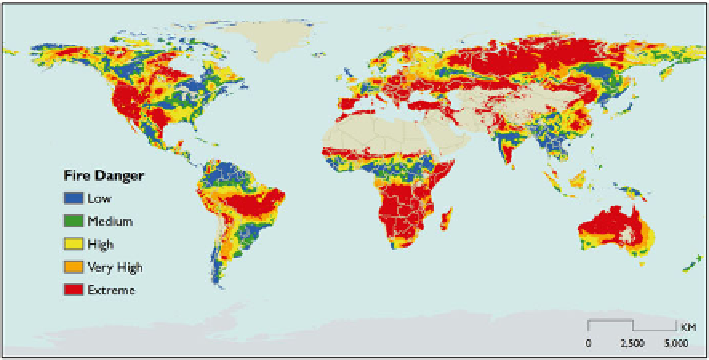Geoscience Reference
In-Depth Information
Fig. 7.5
Example of a global-level product, indicating the Fire Weather Index (FWI) of the
Canadian Forest Fire Weather Index System for 28 July 2013
(see Fig.
7.5
). By using a globally consistent scale, the Global EWS provides a
means of interpreting and comparing relative fi re danger conditions across coun-
tries, continents, and biomes. All fi re danger maps are supplemented with MODIS
hot spot data for visual comparison with current fi re activity. Global level products
are made available via the Global Fire Monitoring Centre website, and the GOFC-
GOLD Fire IT website. In future, early warning products will also be provided by
the European Commission - Joint Research Centre (JRC), which provides the
European Forest Fire Information System (EFFIS). The JRC is developing 1-14
day forecast global fi re danger (FWI System) products calculated using data from
the European Centre for Medium-Range Weather Forecasts (ECMWF).
10
Those
products (which will be available on the EFFIS and GOFC-GOLD Fire IT web-
sites) will provide a second estimation of future fi re danger. Comparison of global
fi re danger by the two forecast models (NCEP and ECMWF) can be made on the
GOFC-GOLD Fire IT website. It is envisioned that Global EWS-Fire products
will be tailored in the future to meet specifi c international information needs for
agencies such as the UNISDR, Food and Agriculture Organization, World Health
Organization, and the United Nations Environment Program.
Global EWS-Fire products can be used to compare fi re danger around the world
because they use a globally consistent calibration. As stated previously, this type of
information is useful for making large-scale fi re management decisions by under-
standing future fi re danger trends across continents and over longer time periods.
However, a single fi re danger value has different meanings (in a fi re management
context) in different parts of the world because of differences in the local fi re regime.
For example, a Drought Code value of 500 may be interpreted as an extreme fi re
danger condition in northern boreal forests where there usually is frequent seasonal

Search WWH ::

Custom Search